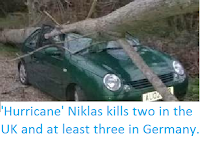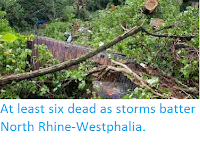Seven people have have died as an Atlantic storm brought hurricane force winds to parts of northwest Europe on Thursday 18 January 2017, with at least seven people having died and widespread disruption to power and transport networks across Germany, the Netherlands Belgium and the UK.
Trucks overturned by high winds halt traffic close to Erfurt in Thuringia, central Germany, on 18 January 2017. Jens Meyer/Associated Press.
Three people are known to have died in the Netherlands; a 62-year-old truck driver who was killed by falling timber while attempting to clear debris from a road near the village of Olst in Overijssel Province, a second 62-year-old man was killed when a tree was blown onto his car, and a 66-year-old man died after being blown over, both in the city of Enschede, also in Overijssel. The port in Rotterdam was forced to close after several shipping containers were blown over, a number of houses had their roofs ripped off and road networks were severely disrupted by about 25 trucks being blown over in and around the city, while in Amsterdam Schiphol Airport was forced to close for several hours.
Damage to a home near Moerdjik in North Brabant Province in southern Netherlands. Marcel Otterspeer Fotografie.
In North Rhine-
A car damaged by a falling tree in Moers in North West Rhine-Westphalia, Germany, on 18 January 2018. Christoph Reichwein/AP.
In Belgium a woman was killed when a falling tree hit her car near Brussels, the port of Ghent was temporarily closed, and many road and tram networks were disrupted by fallen trees. Road networks were also disrupted in parts of the UK, with areas of southern England suffering power outages due to downed power lines.
Ocean
storms form due to heating of air over the sea in tropical zones. As
the air is heated the the air pressure drops and the air rises, causing
new air to rush in from outside the forming storm zone. If this zone is
sufficiently large, then it will be influenced by the Coriolis Effect,
which loosely speaking means the winds closer to the equator will be
faster than those further away, causing the storm to rotate, clockwise
in the northern hemisphere and anticlockwise in the southern hemisphere.
Whilst
the high winds associated these storms is extremely dangerous, the real
danger from such storms is often the flooding. Each millibar drop in
air pressure can lead to a 1 cm rise in sea level, and large storms can
be accompanied by storm surges several meters high. This tends to be
accompanied by high levels of rainfall, caused by water picked up by the
storm while still at sea, which can lead to flooding, swollen rivers
and landslides; which occur when waterlogged soils on hill slopes lose
their cohesion and slump downwards, over whatever happens to be in their
path.
See also...
Follow Sciency Thoughts on Facebook.









